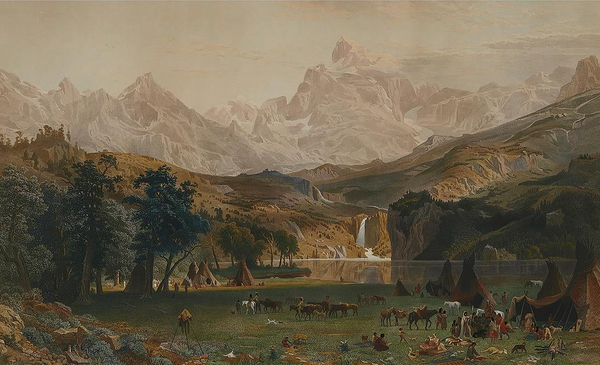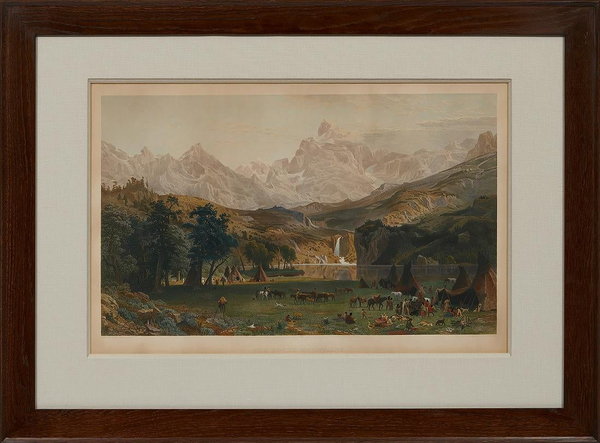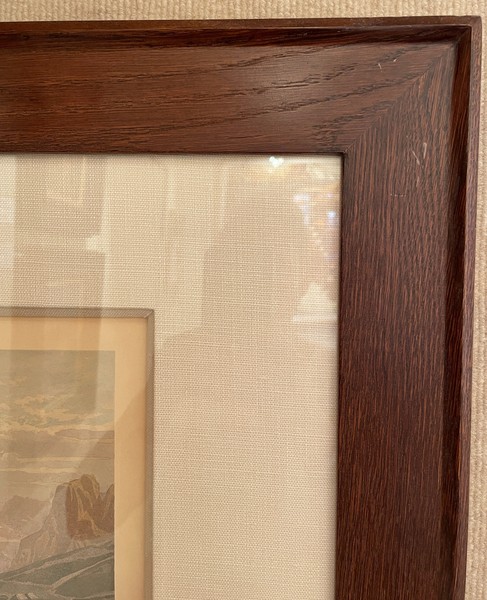Albert Bierstadt (1830-1902)
View Artist Biography



SOLD
Title:
The Rocky Mountains, Lander's Peak
Date:
1868
Size:
16 3/4 x 28 1/4 inches
Medium:
Hand-colored steel engraving
Signed in plate lower right Bierstadt 1868
Titled lower right
Painted by A. Bierstadt lower left
Engraved by J. Smillie lower right
Entered According to Act of Congress in the Year 1866 by Edward Bierstadt in the Clerk's Office of the U.S. District Court for the Southern District of New York lower center
16 3/4" x 28 1/4"
This is an original done by Albert Bierstadt a few years after the original painting that was done in oil on canvas in 1863.
The original painting is oil on canvas; 73 1/2 x 120 3/4 in. (186.7 x 306.7 cm)
This painting is the major work that resulted from the artist's first trip to the West. His intention to create panoramic views of the American frontier was apparent by December 1858, just before he embarked on the trip. In early 1859 he accompanied a government survey expedition, headed by Frederick W. Lander, to the Nebraska Territory. By summer, the party had reached the Wind River Range of the Rocky Mountains in what is now Wyoming. Bierstadt dubbed the central mountain in the picture Lander's Peak following the colonel's death in the Civil War. This was one of a number of large works painted after Bierstadt's return from these travels. It was completed in 1863, exhibited to great acclaim, and purchased in 1865 for the then-astounding sum of $25,000 by James McHenry, an American living in London. Bierstadt later bought it back and gave or sold it to his brother Edward.
Albert Bierstadt (BEER stat) was born in Prussia, which was a large German state. (This land today is in Germany, Poland, and Russia.) He came to America with his parents when he was two years old.
As he grew up, he taught himself to paint. Then he decided to go to Dusseldorf, Germany to study with a group of artists, which today is referred to as the “Düsseldorf style”. They toured Europe. Bierstadt first started painting landscapes in Europe, then he came to America.
He painted the magnificent scenes in Yosemite. When people saw the paintings, they wanted to go there and see it for themselves. As a result, many people went to Yosemite, and the land was no longer unspoiled, Bierstadt went elsewhere to paint.
In 1859 the artist made a trip to the Colorado and Wyoming territories with Frederick Lander, who was in charge of a government survey expedition. He was inspired to paint this beautiful scene of the Rocky Mountains. Indians are encamped in the valley. This is a large painting; six feet high and ten feet long.
Titled lower right
Painted by A. Bierstadt lower left
Engraved by J. Smillie lower right
Entered According to Act of Congress in the Year 1866 by Edward Bierstadt in the Clerk's Office of the U.S. District Court for the Southern District of New York lower center
16 3/4" x 28 1/4"
This is an original done by Albert Bierstadt a few years after the original painting that was done in oil on canvas in 1863.
The original painting is oil on canvas; 73 1/2 x 120 3/4 in. (186.7 x 306.7 cm)
This painting is the major work that resulted from the artist's first trip to the West. His intention to create panoramic views of the American frontier was apparent by December 1858, just before he embarked on the trip. In early 1859 he accompanied a government survey expedition, headed by Frederick W. Lander, to the Nebraska Territory. By summer, the party had reached the Wind River Range of the Rocky Mountains in what is now Wyoming. Bierstadt dubbed the central mountain in the picture Lander's Peak following the colonel's death in the Civil War. This was one of a number of large works painted after Bierstadt's return from these travels. It was completed in 1863, exhibited to great acclaim, and purchased in 1865 for the then-astounding sum of $25,000 by James McHenry, an American living in London. Bierstadt later bought it back and gave or sold it to his brother Edward.
Albert Bierstadt (BEER stat) was born in Prussia, which was a large German state. (This land today is in Germany, Poland, and Russia.) He came to America with his parents when he was two years old.
As he grew up, he taught himself to paint. Then he decided to go to Dusseldorf, Germany to study with a group of artists, which today is referred to as the “Düsseldorf style”. They toured Europe. Bierstadt first started painting landscapes in Europe, then he came to America.
He painted the magnificent scenes in Yosemite. When people saw the paintings, they wanted to go there and see it for themselves. As a result, many people went to Yosemite, and the land was no longer unspoiled, Bierstadt went elsewhere to paint.
In 1859 the artist made a trip to the Colorado and Wyoming territories with Frederick Lander, who was in charge of a government survey expedition. He was inspired to paint this beautiful scene of the Rocky Mountains. Indians are encamped in the valley. This is a large painting; six feet high and ten feet long.
